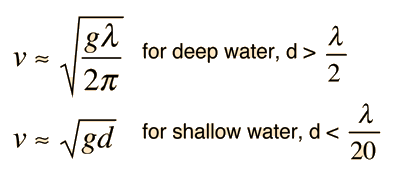The USS Ramapo in Mountainous Waves
In February, 1933, the USS Ramapo, a 146 meter (478 ft) Navy oiler found itself in an extraordinary storm on its way from Manila to San Diego. The storm lasted 7 days and stretched from the coast of Asia to New York, producing strong winds over thousands of miles of unobstructed ocean. Driven from behind by winds on the order of 60 knots, the crew had time to carefully observe the nearly sinusoidal mountainous waves. An officer on the deck observed the crest of the wave approaching from behind just over the level of the crow's nest while the stern of the ship was at the trough of the wave. Subsequent scaling yielded the height of 34 meters for the wave.
Ocean Waves-Their Energy and Power, Ned Mayo, Physics Teacher 35, September 1997 p352
Waves and Beaches, Willard Bascom, Doubleday, 1964 p58-59.
| HyperPhysics***** Mechanics | R Nave |


